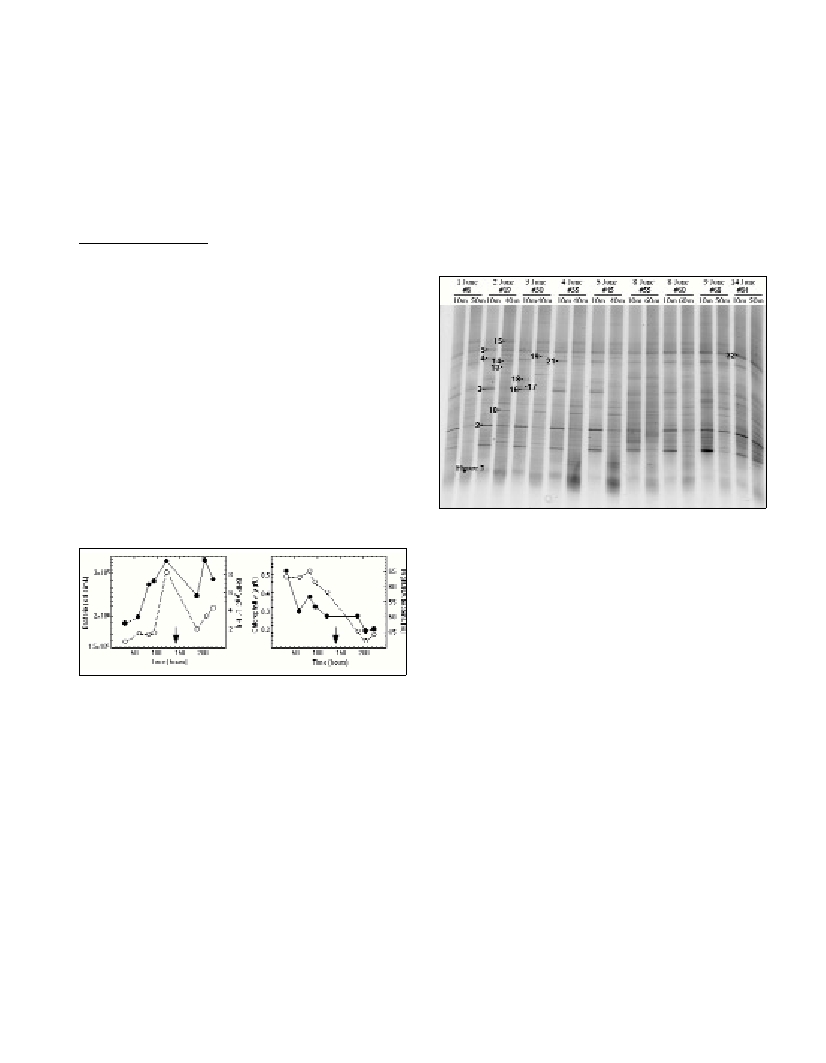GROWTH AND PHYLOGENETIC COMPOSITION OF THE BACTERIAL ASSEMBLAGE
DURING A LAGRANGIAN STUDY IN THE RHONE RIVER PLUME
Vanessa Balagué*, Beatriz Díez, Andrea Malits, Ramon Massana, Cèlia Marrasé, Carlos Pedrós-Alió
Institut de Ciències del Mar, CMIMA, CSIC, Ps. Marítim de la Barceloneta 37-49,
E-08003 Barcelona, Catalonia, Spain, * vbalague@icm.csic.es
Abstract
The Rhone River drains freshwater into the northwestern Mediterranean forming a plume that moves along the slope of the Catalan
continental platform. This plume constitutes a water mass that can be followed in time in a Lagrangian way. We followed the water mass
in cruise ARO2000 on board B/O García del Cidin early June 2000. Hydrography, concentrations of nutrients and the abundance and
activities of microorganisms were determined simultaneously. Here we present the abundance, heterotrophic production and phylogenetic
composition of the bacterioplankton in the plume.
Keywords: DGGE, Plume
Rapp. Comm. int. Mer Médit., 37,2004
264
The plume was tracked by three Argos buoys. Waters in the vicinity
of the buoys were sampled at least once a day. Samples were taken
with Niskin bottles in a rosette with a CTD profiler. Bacteria were
counted by ?ow cytometry. Aliquots were incubated with
3
H-leucine
to determine bacterial heterotrophic production.
Samples for DNA were filtered through 0.22 µm pore diameter
Sterivex filters. DNA was extracted according to Schauer et al. (1). A
PCR amplification was carried out with bacterial specific primers and
the products were separated in a DGGE. The most abundant bands
were excised and sequenced (2).
Figure 1 shows bacterial numbers (filled circles), bacterial
heterotrophic production (empty circles), chlorophyll a (empty
circles) and the percent of high DNA bacteria (filled circles). There
was a storm on June 6 (arrow in Fig 1) that changed conditions. The
first five days can be safely assumed to represent the same water mass
and the same microbial assemblage. Bacteria grew during this period
as chlorophyll decreased. Bacteria almost doubled in four days and
there was a parallel increase in bacterial heterotrophic production. The
percent of high DNA bacteria was relatively high during the first three
days and decreased thereafter.
Figure 2 shows the DGGE gel for the whole period. For each
sampling date, two samples are shown. The sample from 10 m depth
corresponds to the plume and the second one to deeper water below
the plume. The band patterns for the plume and the water outside were
quite different. Thus, the plume had its own bacterial assemblage. On
the contrary, the band patterns were very similar through the
Lagrangian part of the study. Only after the storm some differences
were observed. Most of the sequenced bands belonged either to the
Cytophaga-Flavobacterium or to the alpha-Proteobacteria groups. All
of the bands were closely related to uncultured clones. The only
exception was band 5 that belonged to the recently isolated SAR11
group. A rather predominate band [2] was related to the Roseobacter
clade.
The dynamics of bacterioplankton populations in the ocean are
largely unknown. We have attempted to determine the scales in space
and time at which bacterial assemblages change in the ocean. In
previous studies we looked at spatial (1) and temporal (2) changes in
the composition of the bacterioplankon in the coastal northwestern
Mediterranean. The present study concentrated on short time changes
in the bacterioplankton taking advantage of a hydrographical situation
that allowed a Lagrangian study. Despite a doubling in bacterial
numbers, the composition of the assemblage did not change
significantly. Only after a storm occurred some changes were apparent
in the DGGE band patterns. This constancy is consistent with the very
smooth and slow changes in composition that we had observed in a
seasonal study (2).
References
1 - Schauer, M., R. Massana and C. Pedrós-Alió. 2000. Spatial differences
in bacterioplankton composition along the Catalan coast (NW
Mediterranean) assessed by molecular fingerprinting. FEMS Microbiol.
Ecol.,33: 51-59.
2 - Schauer, M., V. Balagué, C. Pedrós-Ali and R. Massana. 2003.
Temporal changes in bacterioplankton diversity in the oligotrophic
Mediterranean Coast. Aquatic Microbial Ecology, 31:163-174.

